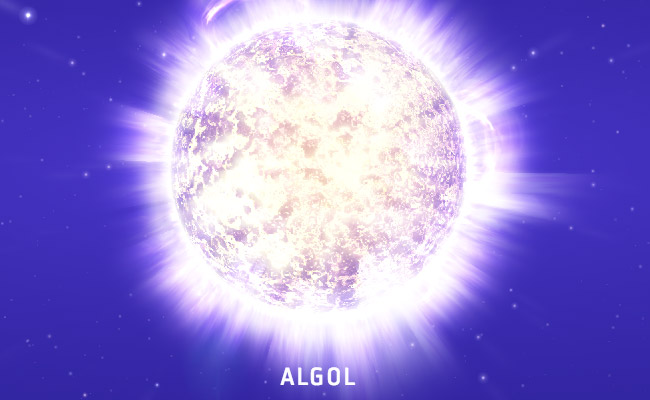Algol – Star Facts

Algol is a triple-star system which dims on a regular basis and when at its brightest it shines three times that as when it’s dimming. This star represents the head of mythological monster, Medusa. In fact, its name is derived from the Arabic language (ra’s al-ghul) meaning, “the demon’s head.” It is also sometimes referred to as Beta Persei.
Constellation Home
Algol is located in the constellation of Perseus and approximately 92.8 light-years in distance. To locate this wonder, star-gazers should start at the tell-tale signature “W” or “M” of Cassiopeia, moving down to the star of Gamma Cassiopeia, through Ruchbah. From this star its a short glimpse to Perseus then down to Angol.
Observation
One of the reasons Algol is so popular is because it is visible to the unaided eye. Although, this star is seen in the mid-Northern latitudes all year long, it is best viewed in the autumn to spring months in the evening. In the Northeast, Algol can be viewed in fall, shines overhead in the winter months then moves back to the Northwest sky in the spring.

Star Characteristics and Features
This celestial wonder is noted for being the first eclipsing binary star to ever be located, as well as one of the first variable stars to be found. Algol is considered a triple star system with Beta Persei A (Algol A) being eclipsed by Beta Persei B (Algol B) with an apparent magnitude varying from 2.1 to 3.4. These two stars are separated by 0.062 astronomical units. The last star to make up this system is Beta Persei C (Algol C). This dimmer star also experiences an eclipse by the two primary components. In addition, Algol is also a prototype for the Algol variable class of stars.
Brightness of the Star
The luminosity of Algol depends on the time of viewing. As an eclipsing binary, the star dims and brightens on a regular basis, completing a cycle every 2 days, 20 hours and 49 minutes. For this reason, the star may appear at times to be winking. Each of Algol’s stars have a different spectral class; Algol A is a B8V, Algol B is a K0IV and Algol C is an A5V. At Algol’s brightest it is three times more luminous than when it is at its dimmest and is considered to shine to the brilliance of a second-magnitude star.
History and Mythology
Historically, Algol changed the way astronomers viewed the life-cycle of a star. Their original thinking was a star’s rate of evolution was dependant on its mass; however, the massive Algol A star is still on the main sequence, while Algol B is much smaller and already on its way to being a subgiant. The reason? Algol B filled its Roche lobe (the space around a binary that has matter bound to it in it gravitational pull). When Algol B expanded beyond this space the matter was transferred to Algol A. This system also emits X-rays and radio wave flares. In mythology, Algol is used to represent Medusa’s head of demonic snakes, which was used by Perseus to change Cetus the sea monster into stone. Some believe this variable star is Medusa’s eye still winking her evil at the Earth.
Algol is not just another twinkling celestial object, it has some cold hard facts and true significance. So if you have a chance to view this “demon head ghoul” be sure to take a peek at one of the most intriguing views you may ever experience.
